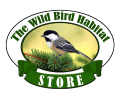Backyard Bird Feeding, Featured, Published articles by Wild Bird Habitat
Bird Feeding 101
Backyard Bird Feeding 101
By: Dave Titterington
The Wild Bird Habitat Store
October – A time of change. Winter will soon be settling in across the Central Great Plaines, and the signs are everywhere. Shorter daylight hours are changing the leaves from summer’s green to autumn’s gold, red and orange. The sweet aroma of a wood fire drifts from a chimney. And the blackbirds are massing in treetops, waiting to be escorted south by the early first cold fronts.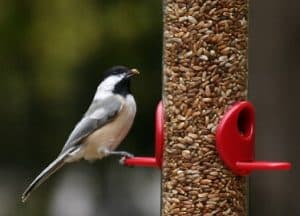
Our winter birds, the Red-breasted Nuthatch, Dark-eyed Juncos, Harris’s, White-crowned, and White-throated sparrows and others will be arriving from the north. They are replacing the birds of summer, such as orioles, grosbeaks and catbirds, which are now but warm weather memories. The warblers who have nested to our north are passing through this month, stopping in our yards for a splash in the birdbath and to glean what insects remain in our trees and shrubs before retreating further south ahead of the approaching winter. Yes, autumn is a time of great change and a transition for our birds.
Autumn is also a time when many folks who didn’t maintain a bird feeder or two during the summer months begin to consider providing a supplemental food sources for our backyard birds during the winter. After all, when the snow blows and the temperatures plummet, our resident winter birds are a short 36 hours from starvation. They only survive winter’s frigid nights on what foods they can consume during the daylight hours. This is why birds do not rely on any one food source that may become depleted or covered in snow and ice.. They stake out multiple natural food plots, along with the supplemental feeds offered in backyard bird feeders and often rotate to them throughout the daylight hours. Getting the bird feeders ready now will ensure the birds will visit them in the winter as they go about their daily food routes.
Feeding birds in our backyards has become more than just a passing hobby. In fact, birding in the United States has become the fastest growing outdoor recreational activity for families and individuals. Birds entertain us. They educate us. They provide a way to relax from a busy day and connect with nature. But what does it take to feed birds and attract them to our backyards? It’s very simple. Birds find food by sight. You provide the food, and they will come.
In the past, many people would just scatter the bird seed on the ground or possibly have a single bird feeder filled with a generic wild bird mix, expecting all birds to enjoy their fill. However, backyard bird feeding has become more specialized, targeting the specific feeding habits of birds to meet their needs. Some birds will only feed at elevated levels, like the chickadees and gold finches. Others, such as juncos, doves and native sparrows feed primarily on the ground. Yet other birds, like our woodpeckers and nuthatches, prefer to feed around the tree-trunk zone. Then there are those, such as the cardinals and blue jays, who are just plain opportunistic. These birds will feed wherever the seed is available to them.
Two of the most common types of bird feeders for attracting a large variety of birds are hopper feeders and platform feeders. Except for birds that forage on the ground, these two feeders will attract both large and small birds. Cardinals to House Finch.
Other popular bird feeders are seed tube feeders and Nyjer thistle feeders. These bird feeders are more specialized, primarily attracting the smaller birds, from chickadees and nuthatches to finches, redpolls and crossbills. Today’s tube feeders are constructed with durable poly-carbonate tubes, die-cast metal seed ports, tops and bottoms with a heavy bail wire to hang it.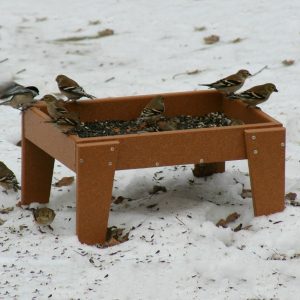
A bird feeder that is not often considered but makes an exciting addition to a backyard bird-feeding program is the ground feeder. Ground feeders are simply platforms with legs that sit on the ground to attract the many birds that only feed at ground level. These birds include all our native sparrows, a few of which are the Harris’s sparrow, White-crowned Sparrow White-throated Sparrow. Also, Dark-eyed Juncos, which visit us in the winter, and are ground foragers as is the towhees and mourning doves. A good mix for ground feeding birds is white or brown safflower seed combined with some white Proso millet.
With all those little brown birds scooting around in your yard, you may wonder which are native and which aren’t. If you’re watching a small brown bird feeding on the ground in your yard and you’re not sure if it is a native sparrow (a good sign you need to retrieve your field guide to identify this bird), or is it a House Sparrow? Watch the bird’s method of feeding. All native sparrows scratch the ground with their feet to turn up seeds. The common house sparrow, on the other hand, is a weaver finch that uses its bill to sweep the ground for food. This bird was introduced into North America from England around 1850 and, as with European starling, is a non-federally protected invasive species.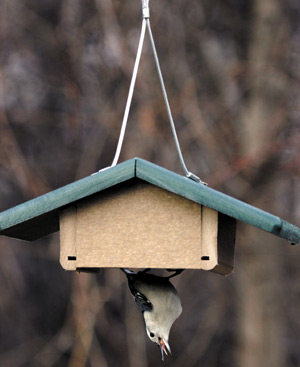
Suet feeders can really expand your backyard bird feeding excitement. Woodpeckers, nuthatches and brown creepers are birds of the tree-trunk zone. These birds will feed on seeds in most elevated bird feeders, but they are easy to attract to the animal fat in suet. But don’t think of suet as purely a wintertime food source. Woodpeckers will consume 30 percent more animal protein (suet) from March through August than they do all winter long. And Carolina Wrens, which are wintering over increasingly in Nebraska, will also feed on suet, as will chickadees.
Just as the type of bird feeder you select determines which birds you will attract, the birdseeds you fill them with are just as important. Birds that feed at elevated hopper, platform, and seed tube feeders prefer sunflower seed, safflower seed and other nut-based mixes. If you put a general wild bird mix in these feeders, they will sweep through it, picking out the nut meats, scattering everything else to the ground.
Thistle feeders are specialized bird feeders for attracting finches. During the winter months they are also a favorite of pine siskins and Redpolls. The seed used in these feeders is limited to Nyjer thistle seed or a finch mix.
months they are also a favorite of pine siskins and Redpolls. The seed used in these feeders is limited to Nyjer thistle seed or a finch mix.
Caution should be taken to ensure the thistle seed is fresh. Nyjer thistle is not a true thistle, but a coreopsis imported from India and Ethiopia. Once in reaches the United Stated, it is sterilized prior to distribution to prevent germination of non-native plants. This sterilization process creates a shelf life of four to six months, after which the finches will slowly begin to ignore it when put in a feeder. If using a finch mix, avoid those containing canary grass seed, flax and other fillers. The best finch mix is half Nyjer thistle and half ground sunflower chips. The best of both worlds for finches
A general wild bird mix starts with a base of white Proso millet. Sunflower seeds, cracked corn, and peanuts are then added. These mixes are best used on platform and ground feeders where birds can select the seeds they want without sweeping through it. Again, caution should be taken when purchasing a general wild bird mix. All birdseed is required to be labeled with the ingredients and the order of its content. Many inexpensive wild bird mixes contain filler seed such as milo, wheat and red millet, and the label may even state “assorted grain products”. These products are rarely eaten by backyard birds, if at all, and as much as 40 percent of a bag of economy wild bird feed will be scattered and wasted on the ground. A quality general wild bird mix may cost a bit more but will add up to big savings in the long run and you’ll attract more birds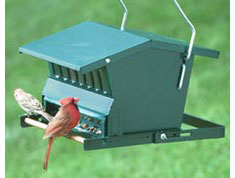
If squirrels are robbing the seed from your bird feeder you intended for the birds to enjoy, you may want to consider adding a squirrel baffle or investing in a squirrel-proof bird feeder. Another alternative is to use white safflower or Nutra-Saff safflower seed, in the bird feeder that the squirrels raid the most often. Squirrels do not care for its bitter taste. Grackles, the large black birds that seem to overpower the bird feeders at times, do not have much of a taste for safflower either. Yet it will attract most all your favorite backyard birds and either safflower seed can be used in just about any type of feeder.
Water for birds, especially during the winter months, is essential for their survival. Although they have numerous food sources, open water in the winter can become difficult to locate. So having an open source of water in the winer will attract more birds than bird seed alone. There is an assortment of birdbath heaters and heated bird baths on the market that are thermostatically controlled and use less energy than a 60-watt bulb. Fresh water does more for birds than just meet their hydration needs, but clean feathers from a quick bath provide better insulation to keep warm during cold nights.
Finally, consider planting some habitat in your yard. All living things on our planet require food, water and shelter. Hedges and shrubs will not only offer protection from bitter winter winds but a place for birds to nest and a natural food source. Consult a master gardener at your local nursery or the Nebraska Cooperative Extension Office about planting habitat for wildlife. Follow these tips from Wild Bird Habitat Store, then sit back and enjoy a backyard filled with your feathered friends.
